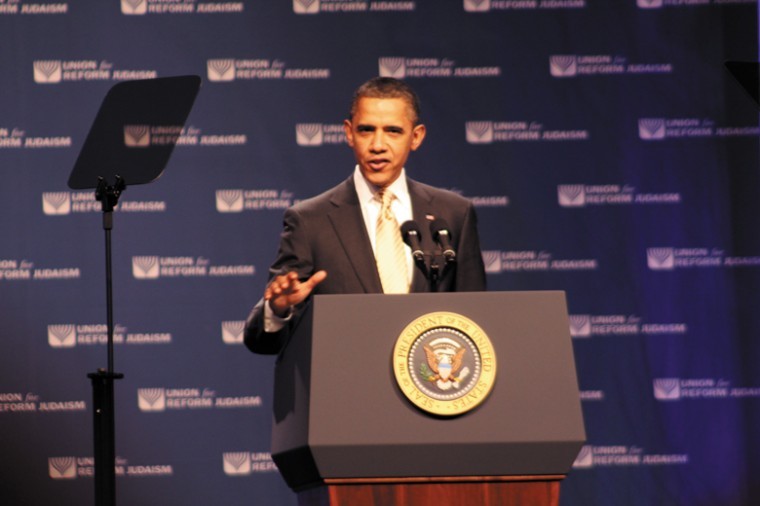St. Louisans active at the URJ Biennial
Published December 21, 2011
It may have been 800 miles away but between making presentations, providing entertainment and meeting a sitting president of the United States, St. Louisans and the Gateway City played a big role in last week’s Union of Reform Judaism Biennial in Washington D.C.
“There was a lot of great representation from our community,” said Rabbi James Bennett of Congregation Shaare Emeth. “I think you are going to see some initiatives over the coming months and years that are going to be a direct outgrowth of some of the learning that took place here.”
The five-day Biennial, which concluded Sunday, was the largest in the URJ’s history, hosting some 6,000 participants who attended seminars, heard presentations and went to talks by a dozen big name speakers ranging from Ehud Barak and William Kristol to Natan Sharansky and Rep. Eric Cantor. Nearly 50 entertainers performed at the massive conference, the 71st in the organization’s history, including St. Louis-based rockers Sheldon Low and Rick Recht.
Bennett, who led a dozen participants from Shaare Emeth, spoke to the Jewish Light by phone just after President Barack Obama finished his keynote talk. The rabbi said the speech went over well with his audience.
“I’m sure that for many, many people, that was the highlight of the weekend,” Bennett said. “It was quite compelling and powerful. He spoke directly to the entire assembly and his message was beautifully crafted.”
It was certainly the highlight for several members of United Hebrew Congregation who were part of a group that was actually able to briefly meet the president. For UH Rabbi Roxanne Shapiro, the opportunity to shake the president’s hand reminded her of her high school days as president of the North American Federation of Temple Youth.
“I remember hoping then that I’d be invited that year to the White House as the president of the youth movement but never was,” she said. “It’s only fitting that at a Jewish program such as this I got that opportunity.”
Shapiro said the services were also a moving moment.
“Having 5,000 people praying, worshipping, singing together is just an overwhelming experience,” she said. “We’re used to having own community together in worship but to bring people from all over North America and know that all these people, however different we all may be, can come together is something that I think you actually have to be there to understand.”
UH’s Rabbi Brigitte Rosenberg was also among the St. Louisans who met the president. She said there was good energy at the conference and that it was the best of the Biennials she’s attended.
She found the educational sessions, which talked about methodologies for increasing volunteer and congregant engagement, very rewarding.
“It’s no longer just the traditional ways of just worship,” she said, “but people are looking for different ways to connect in the Jewish community and I think that synagogues can offer a variety of ways in which people can connect but we have to get past old ideas and modes.”
The URJ is marking something of a change in mode itself, transitioning to a new president, Richard Jacobs, a Scarsdale, N.Y. rabbi who has held various leadership positions in the Reform Movement. He replaces Rabbi Eric Yoffie who held the post for 15 years.
Rosenberg said she felt renewed confidence upon hearing talks by both the incoming and outgoing leaders.
“It just gave you a sense that we’re moving in a good direction, that people have been doing a lot of thinking and a lot of work,” Rosenberg said.
For Amy Stone, director of development at UH, it was her first such event. “It was wonderful to see and listen to so many lay leaders and professionals on their great ideas,” said Stone, who also shook Obama’s hand. “I took as many notes as I possibly could.”
Steve Friedman, a member and former president of Central Reform Congregation, called the event “inspiring,” noting that he enjoyed the speakers. “It delivered great opportunities for learning, networking, and spiritual enrichment,” said Friedman, a member of the URJ board. “But, perhaps most importantly, it helps remind me that we are all part of something bigger than ourselves.”
Rabbi Justin Kerber of Temple Emanuel said he found a session by Rabbi Howard Berman of the Society for Classical Reform Judaism to be enlightening. He also was struck by Obama’s keynote, which cited Jewish sources and mentioned that his own daughters were of the age at which they were attending a lot of bar and bat mitzvahs. The speech was “It wasn’t just that he was aware that he was speaking to a Jewish group but really gave a speech that was truly a D’var Torah,” said Kerber. “It was hard to overstate what an historic moment this was because the last sitting president to address the convention was Ulysses S. Grant.”
Temple Israel’s Leslie Wolf wasn’t just there as an attendee but also as a presenter. Wolf led a session to talk about Jewish Parents as Teachers (JPAT), a groundbreaking program she is pioneering at TI, which aims to help connect Jewish families with young children into the community early on. The URJ helped fund the program with a grant.
“There were probably between 50 and 60 people I presented to and it went over really well,” said Wolf, who directs the Deutsch Early Childhood Center. “I got lots of questions on how we got money for the grants, how we started it and how the community has been receptive to it.”
Engagement with the next generation was a major theme of the convention. “What I really came away with from this convention is that especially with youth, everybody has to look at the big picture and creating Jewish identity,” Wolf said. “Jewish preschools, temples and synagogues all have to work together in engaging young families with Jewish identity.”















